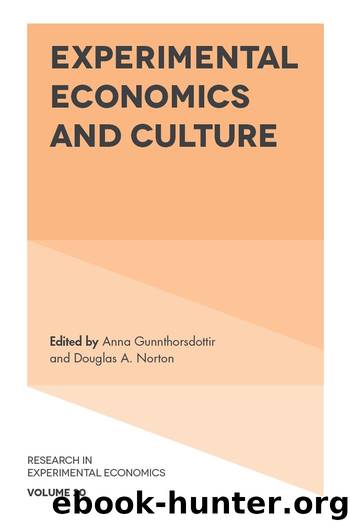Experimental Economics and Culture by Gunnthorsdottir Anna;Norton Douglas A.;

Author:Gunnthorsdottir, Anna;Norton, Douglas A.;
Language: eng
Format: epub
Publisher: Emerald Publishing Limited
Published: 2018-11-21T00:00:00+00:00
Fig. 2. Dictator and Ultimatum Games: Percent Offered by Player 1, by Typology. Notes: Cut point for grid and group is 0.5. p-value for the WilcoxonâMannâWhitney test.
6.3. Standard Ultimatum Game
Mean offers increase to 45.4% of 10 dollars as compared to 35.5% in the dictator game. Consistent with previous findings (Engel, 2011), percent of population offering half of their endowment rose from 28 in the dictator game to 38, and percent of subjects offering from 1 to 4 dollars fell from 44% in the dictator game to 39%, and only 3% of population offered zero money to their match as compared with the 16% in the dictator game. In the ultimatum game, cultural values played a significant orole.
Result 2 [Standard Ultimatum Game]Hypothesis H2-A is supported: Proposers with higher group scores make higher offers. Hypothesis H2-B is also supported, and hypothesis H2-C is marginally supported: responders with higher group scores and those with lower grid scores accept lower offers.
Support: Table 6, regressions (3)â(6). The group score significantly and positively affects offers (pâ<â0.1 for baseline regression (3), and pâ<â0.05 for regression (4) with citizenship clusters). Responders with a higher group score have a lower minimum acceptable amount than those with a lower group score (pâ<â0.05 for both specifications (5) and (6) with and without citizenship clusters). Consistent with hypothesis H2-C, responders with a higher grid score have a higher minimum acceptable amount; the difference is marginally significant (pâ<â0.1, regressions (5) and (6)).
Comparing the behavior across four cultural types provides additional support for H2-A. Distributionists (high-group and low-grid) offer 49.5%, as compared to 43.3% offered by individualists (low-group and low-grid); the difference is marginally significant (pâ=â0.096). See Table 5 and Fig. 2.
In addition, we find that donations in the dictator game are smaller than offers in the ultimatum game across all four cultural types (pâ<â0.02). However, the differences in donations in the dictator game and offers in the ultimatum game become insignificant for group scores below 0.3 or above 0.7 (pâ=â0.1447 and 0.1020), suggesting that for participants with very low- and very high-group values, the strengths of their social welfare orientation dominate strategic differences between these two games.
Download
This site does not store any files on its server. We only index and link to content provided by other sites. Please contact the content providers to delete copyright contents if any and email us, we'll remove relevant links or contents immediately.
The Brazilian Economy since the Great Financial Crisis of 20072008 by Philip Arestis Carolina Troncoso Baltar & Daniela Magalhães Prates(121357)
International Integration of the Brazilian Economy by Elias C. Grivoyannis(91285)
The Art of Coaching by Elena Aguilar(52948)
Flexible Working by Dale Gemma;(23254)
How to Stop Living Paycheck to Paycheck by Avery Breyer(19638)
The Acquirer's Multiple: How the Billionaire Contrarians of Deep Value Beat the Market by Tobias Carlisle(12241)
Thinking, Fast and Slow by Kahneman Daniel(12079)
The Radium Girls by Kate Moore(11921)
The Art of Thinking Clearly by Rolf Dobelli(10224)
Hit Refresh by Satya Nadella(9039)
The Compound Effect by Darren Hardy(8811)
Tools of Titans by Timothy Ferriss(8218)
Atomic Habits: Tiny Changes, Remarkable Results by James Clear(8186)
Turbulence by E. J. Noyes(7936)
A Court of Wings and Ruin by Sarah J. Maas(7652)
Change Your Questions, Change Your Life by Marilee Adams(7635)
Nudge - Improving Decisions about Health, Wealth, and Happiness by Thaler Sunstein(7615)
How to Be a Bawse: A Guide to Conquering Life by Lilly Singh(7393)
Win Bigly by Scott Adams(7094)
